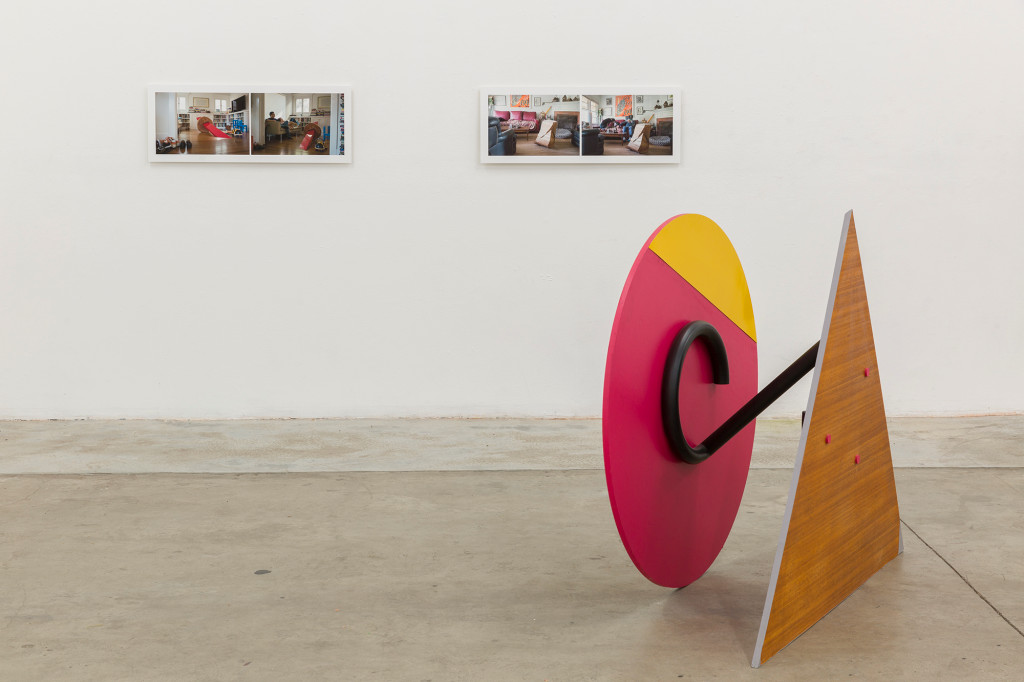[ad_1]
Titled “Dysfunctional Furniture”—a phrase that could qualify as an irreverent definition of sculpture—Ken Ehrlich’s exhibition at Human Resources welcomed a categorical fuzziness around form and utility, bringing together a series of sculptural furnishings designed with neither the pedestal nor the human user fully in mind. These objects function as furniture, but, as the “dys-” implies, badly. They aren’t very useful, nor are they ergonomic or performance-tested. Some are a bit fragile or liable to give you a sharp jab. They imply a set of enigmatic expectations that disregard casual use.
Perhaps to test this dysfunction, Ehrlich reversed the familiar trajectory of an artwork made, displayed, sold, and then situated at the behest of its owner. Ahead of the exhibition, he temporarily installed a number of the pieces in the homes of writers in his Los Angeles community. This entailed ongoing conversations with each participant and an organic match-making process to determine which piece they would temporarily live with. Some of the writers composed short reflections on the experience, published in an illustrated pamphlet accompanying the show.
Assembled in an almost circular configuration, suggesting both conversation and the allure of a showroom, the works were characterized by simple, slightly irregular geometries, the juxtaposition of disparate textures, and flashes of solid red, green, blue, or yellow. In nearly all of them, hard, smooth, and finished surfaces are combined with salvaged timber. In Untitled (table/footrest), 2019, a laminated beam supporting a cantilevered glass tabletop juts out of a notch in a raw wood beam placed on the floor, while in Untitled (side table), 2019, a rectangular pane of glass vertically bisects a hunk of eucalyptus wood. The room was full of alternating sharp and curving edges: the pointy laminated triangle in Untitled (Variability table), 2019, for instance, is joined to a parallel laminate disk by a coil of black metal tubing. Turned on its side, it is a table that could seat no one.
Courtesy Human Resources Los Angeles
The scale and postures of the works make them appear almost creaturely. Various writers in the pamphlet remark that they seem to be in the company of something quasi-sentient, with which they have a sometimes antagonistic relationship. Andrew Culp and Eva Della Lana, who lived with Untitled (shelf), 2019, liken it to both a guest and a ghost, writing: “What we did not anticipate was how it would startle us.” On the walls, photographic diptychs portrayed the pieces both with and without their human hosts, souvenirs of their time together. These images add warmth and intimacy when reproduced alongside the text contributions in the pamphlet, but as framed photographs in the exhibition, they were one layer of meta-commentary too many.
The furnished interior is inevitably an expression of social class, a dimension Ehrlich explores through social reproduction theory. He shared several texts with his writer-collaborators that he identified as sources of inspiration for the project: essays on the relationship of design to everyday life by Italian designers Gae Aulenti and Enzo Mari, and a canonical Marxist-feminist text by Mariarosa Dalla Costa and Selma James, “The Power of Women and the Subversion of the Community” (1972). Because Dalla Costa and James associated the domestic interior with the role of housewife—someone who delivers the conditions that make all other social life possible, typically without recognition—they viewed the traditional family home as a site of oppression. In turn, they argued for a refusal of domesticity equivalent to a strike. Ehrlich’s dysfunctional furnishings take up this idea of a disruptive potential within the material experience of home, attempting to revive these politics for a different place and time.
This article appears under the title “Ken Ehrlich” in the April 2020 issue, pp. 86–87.
[ad_2]
Source link


